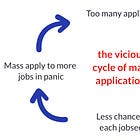Should you ask ChatGPT to write your applications?
If you're using AI to write cover letters, you're working on the wrong problem.
“If you have some free minutes, can you please check my cover letter draft?”
A few weeks ago, I received this LinkedIn message from a new connection. Let’s call them Alex.
“Of course”, I opened the Google Doc draft they sent me.
The cover letter was surprisingly long, one and a half pages. As I read on, I realized the content was incredibly generic. None of the paragraphs seem to have a clear point. Words keep getting repeated and the tone of voice was very rigid. I could barely even find any identifying information about Alex.
Yes, this cover letter was written by ChatGPT. An AI content detector showed that only 16% of it was written by a human.
Okay, AI wrote my cover letter, so what?
“Did you write the cover letter with ChatGPT?” After almost rage-tying out two dozen editing suggestions for how bad the cover letter was, I asked Alex.
“Took an idea,” they said, “I wrote most of it”.
I’m far from the only person receiving AI generated cover letters and struggling to see their value. This Product People applicant for example, forgot to delete AI’s kind reminder for them to edit AI’s output, revealing that they didn’t write their own application…
These 10+ applicants all had the same idea, and it’s pretty clear that the hiring team decided not to hire any of them due to them missing one of the most important traits: strong (and authentic) writing skills.

At this point you might wonder, job searching is so hard these days, I have to send out so many applications to get a response, and every company asks for a cover letter. Everybody knows it’s a numbers game, and I’m not a professional writer, why can’t I get a little help so I can pay rent?
As shown above, using AI cover letters might be more likely to kill your chances. Let me show you why your time and effort can be better spent elsewhere with much higher ROI.
Myth #1: Job searching is a numbers game
Most people only need 1 full-time job. Therefore the ideal scenario is to apply for 1 job and get it, as it maximizes your success rate. This means job searching looks something like this: Number of jobs applied x success rate = Number of jobs got. Because “number of jobs got” only needs to be 1, the ideal scenario is 1 x 100% = 1. You only need to apply to 1 job because you have a 100% success rate.
However, most people also know that reality is not ideal, success rate is almost always lower than 100%, therefore “number of jobs applied” needs to be bigger than 1, but no one knows what their success rate exactly is, thus applying to jobs becomes a lottery where you hope that the next one would be jackpot but end up trying again and again and again with no end in sight.
On top of that, companies like LinkedIn make applying to jobs too easy, because they make money from you viewing, clicking on job ads and applying to as many jobs as you can. And what’s wrong with having a lot of applicants for each job? The bar gets increasingly high and success rate for each person drastically decreases.
Job searching is only a numbers game, if you don’t know anything about your success rate. It’s not a science, so no one can accurately calculate their success rate, but there are many factors that will directly impact it.
When I first landed a job in a startup, I applied to 80 jobs. My success rate was 1.25%. When I landed my current product manager job, after having worked in talent acquisition for 3 years, I purposefully applied to less jobs to spend more effort on companies that would prefer my HR background, such as HR tech companies. I asked 18 people for referrals and received 13. I ended up only applying to 19 jobs, which was a 5% success rate — that’s 62 less applications and potential disappointments!
Myth #2: AI cover letters are better than my own
For recruiters and hiring managers who read hundreds or thousands of applications a year, it’s very easy to spot most AI cover letters. They are so incredibly generic and boring and often contain little to no personal information at all, which is completely against the original point of a cover letter: to demonstrate your unique motivation and highlight key reasons why you’d be good for this job. We WANT the personal stuff about you.
If you feel lost without ChatGPT, here’s a great cover letter template from career coach Jermaine, who’s helped hundreds of people land jobs in tech.
If what you’re concerned about is your English writing skills, the best way to practice is to write it yourself, and then have someone edit it (trust me, I’ve done a non-fiction writing fellowship to launch this newsletter and editing is life-changing). Your end reader is not a an AI; your end reader is a living human being who aren’t expert writers, and often are non-native English speakers. Find a family member, a friend, a mentor, and have them read your cover letter then give editing advice.
Myth #3: If I get rejected it’s because of my cover letter (not true, unless they were AI generated)
This is how my recruiter colleagues and I would read an application:
Usually we agree with the hiring manager in advance on selection criteria and proxies to look out for. Then we start with the CV or resume, scan it for 10 seconds, occasionally up to a minute. In vast majority of the cases, the decision is already made. The most important proxy we look out for is whether this person has done the job. If someone has no relevant experience at all or matches too few of our criteria, the cover letter doesn’t matter in the decision-making process.
Cover letters are more closely looked at, either when a few candidates are close in competition but a decision has to be made; or when the hiring team is specifically looking for strong writing skills or motivation, both can be better exhibited in the cover letter. If it’s the former, companies that have much higher volume of applicants are more likely to encounter this problem. If it’s the latter, the company often makes these requirements explicit in the job ad or lead with a prompt (“Tell us about why you would like to join TechCompany?” or “What makes this job at TechCompany interesting to you?”).

What should I do instead?
Instead of trying to speed run applications with AI, which might actually lower your success rate in many ways, here are 3 concrete things you could do to increase your success rate.
#1: Look for companies that value your unique background
Start with companies most similar to your past employers (maybe even their direct competitors). Then draw the circle bigger and include companies in the same industry. Even if you moved from another career to tech, you can look for companies whose target customers are doing your old jobs.
#2: Look for jobs on websites other than LinkedIn
LinkedIn as the biggest job site built its business model to get you to apply to as many jobs as possible, even to the detriment of your success rate. There are plenty of job sites that are less known but also gives you less competition, like Otta, Elpha for women, Arbeitnow, ProductHunt, WeLoveProduct, MindtheProduct, even the German job bureau Arbeitsargentur. Look out for niche communities and they’ll most likely have a job board somewhere.
#3: Networking to get more job opportunities and referrals
Even if LinkedIn’s algorithm didn’t recommend you the jobs, openings are often shared on social media. Therefore even just by being connected with hiring managers and HR folks, you might have a better chance of seeing the job ad first before it fills up.
As illustrated by my own experience, a surprising 72% of people I approached were willing to give me a referral, which often means your application will get read before your hundreds of competitors or that you’ll immediately land an interview round. Here are 4 real examples of networking messages that worked, and you can steal this referral message I used.
A better career is closer than you think. Good luck!







Hi Annie, I stumbled upon your Newsletter by sheer luck and have not been able to put it down since then. Like many others, I also struggled to land a job during the pandemic. It is a revelation and confidence restoring (and also a relief) to know that I was not alone. Job searching can be mentally exhausting, and there are not many 'practical tips' out there for career changers or someone with a non-linear career path (like me!).
Your insights are easy, straight forward, and sensible. My mind did a little dance when I checked only two boxes from the Generic CV Bingo. I instantly cut them out from my CV. Another key learning I took was from your transition from a Recruiter to a Product Manager. I have been associated with writing and editing for the longest time, and currently want to transition into Tech. I always wondered what kind of Tech company or role would suit me. I will start looking for the perfect intersection between the two now.
I wish I had found your content sooner. Better late than never. Thank you, and keep up the great work. Best, Khimpi Dutta